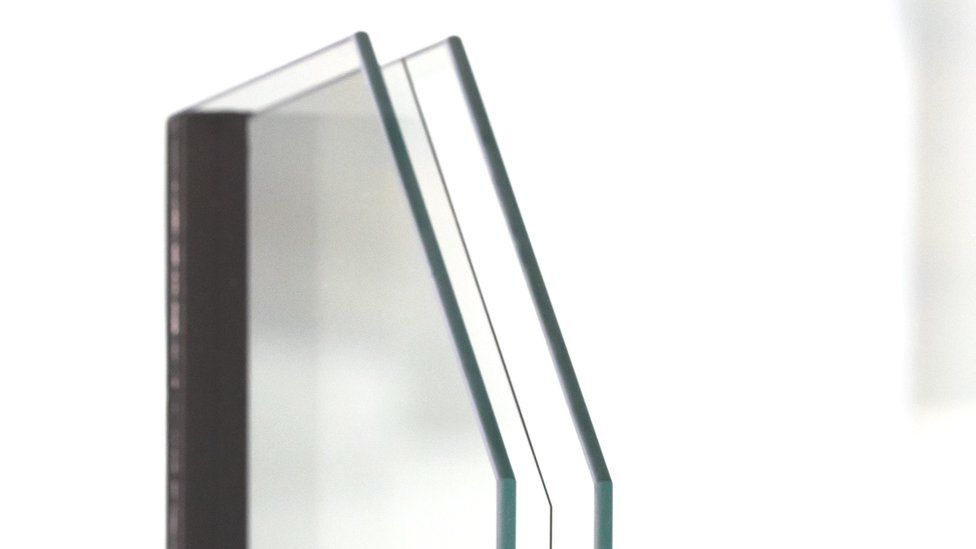Helen Matthews of Sheffield lives in a “proper English house”, as she puts it. “So yes, flippin’ freezing all the time.”

Helen Matthews had triple glazing fitted to her home
Until, she hastens to add, she had triple glazing installed earlier this year. The old wooden-framed double glazing in her semi-detached home was taken out. The house is noticeably warmer, and quieter, now that the triple glazing is in place, she says.
“We used to feel a bit of a draught whenever we stood near the window,” recalls Ms Matthews. “That’s all gone, we don’t feel any of that any more.”
According to government data, the vast majority of British homes, more than 85%, have double glazing. Much works very well, but, in some cases, homeowners are finding that switching to triple glazing vastly reduces heat loss and boosts comfort.
The glazing industry is now gearing up for rising demand for these extra-insulating windows, especially post-2025, when new regulations could make triple glazing the standard in new build properties in England. Plus, a range of new technologies besides triple glazing currently at the research stage could drastically curtail heat loss through windows in the future.
“Everyone treated us like we were weird for wanting triple glazing,” says Mrs Matthews. Even some salesmen tried to put her off. “They were like, ‘Oh, double glazing’s just as good’.”
But she had done her research and was convinced the new windows would be worth the outlay. Triple glazing is not cheap – Mrs Matthews spent £13,500 replacing all her windows and two exterior doors – though she hopes using her heating less will save her money in the long run.
Another homeowner who spoke to the BBC, Hester McQueen in Edinburgh, also had to weigh up the cost of triple glazing recently. Replacing four windows in her semi-detached house in September cost around £6,000, and she wasn’t sure how much of a difference it would make.
But the improvement has been “dramatic”, she says: “The rooms are warmer, the temperature down the stairs seems to be more steady.”
Mrs Matthews also finds that her windows help keep excessive heat out during the summer because triple glazing reduces solar gain.
The idea behind triple glazing is that an extra pane of glass and two separate cavities filled with air or a gas such as argon makes it especially hard for heat inside the home to escape.
Any building material you can think of will have a U-value, a measure of how easily heat passes through the material – the lower the number, the better.
Double glazing typically has a U-value of around 1.2, though U-values just below 1 are now possible for the centre pane of a double glazed window (the U-value including the frame may differ).
Triple glazing, however, can get down to below 0.5. It is considered relatively rare in the UK – the government says it does not have sufficient data to estimate how many homes have it – but things are changing.
“Home owners are asking more for triple glazing,” says Phil Brown, technical advisory service manager (UK and Ireland) at Pilkington UK, a glass manufacturer. “We’re seeing a shift towards that.” The industry is increasingly investing in triple glazing manufacturing facilities, too, he adds.
Though still to be decided, incoming regulations in England could demand windows have a U-value of 0.8 or below. That would almost certainly make triple glazing standard for new builds from 2025 onwards.

Shift to triple glazing “inevitable” says Mark Norcliffe
This transition is more or less “inevitable”, says Mark Norcliffe, managing director of Cornwall Glass Manufacturing, though he adds: “It’s got to be affordable.”
There are plenty of options for reducing heat loss through your existing windows even if you don’t have a budget for replacing them – such as using thicker curtains, sealing up draughts at the edges of frames, and using insulating film.
A simple way of comparing the quality of windows on sale is to look at their energy ratings, suggests Brian Horne, technical knowledge lead at Energy Saving Trust. These ratings are on a scale from A to G, with the best possible rating being A+++. This captures not only the U-value of the glass but other factors, such as the quality of the frame, which greatly affects the overall performance.
Even double glazing has come a long way in the past 20 years, says Mr Brown, largely thanks to glass coatings. There are various approaches but one involves spreading a thin layer of silver onto the surface of a pane, to make it more reflective, which reduces heat loss. Silver is so reflective it could make the glass look like a mirror so, in order to retain transparency, metal oxides are mixed into the coating as well.
Pilkington has a glass product called energiKare that can achieve a U-value of 0.9 in a double glazed centre pane, for example.
There are lots of interesting glazing technologies besides triple glazing, says Hasila Jarimi at the National University of Malaysia. Some are already commercially available, such as vacuum glazing, where two panes are held very closely together but with a vacuum between them. “It’s thin and at the same time it has a very good, low U-value,” she explains.
However, vacuum glazing tends to be especially expensive.
Technologies at the research stage include glazing units containing aerogel – an extremely light, porous material that is an exceptionally good insulator. Aerogel is even more expensive, though, and glazing containing it tends to be translucent rather than perfectly clear, though researchers are working on improving this.

Corning has developed a triple glazing produce with an ultra thin middle pane
Reducing the thickness of triple glazing would make it far more accessible to homeowners who have double glazing currently, since they could simply switch the glazing without having to replace the frames as well. Glass giant Corning, which makes the glass used for iPhone screens, has developed such as product. The middle pane is an ultrathin sheet of super tough “Architectural Technical Glass”, or ATG.
It’s yet to become available in Europe but it could allow for U-values as low as 0.5 for the centre pane.
Separately, Matyas Gutai and colleagues at Loughborough University are working on water-filled windows. These require pipework to allow water to circulate inside the window pane cavity and could achieve U-values of around 0.4 for the window overall. The first pilot projects featuring this technology, including one potentially in the UK, are currently under discussion.
The thing to remember is that each house is different, stresses Philip Griffiths Professor of Building Physics at Ulster University, and replacing windows can be very expensive. While triple glazing could well become standard in the future, he adds that people must also properly ventilate their homes, to reduce condensation and damp, especially when retrofitting or sealing up older properties.
“If we are going to do this correctly, we’ve got to do this right,” he says.
Chris Baraniuk (Source: bbc.com)


